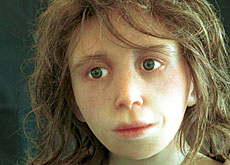
Zurich team offers new visions of old bones

A Swiss-Bolivian research team from Zurich University has been bringing our distant ancestors back to life using a pioneering virtual 3D technique.
Combining their knowledge of computer technology and paleoanthropology, Christoph Zollikofer and Marcia Ponce de Léon have become recognized world experts in the computer-assisted reconstruction of ancient fossils.
Their groundbreaking research, involving a series of high-profile virtual reconstruction projects, has also helped answer important questions about human evolution.
Since 1992 the Zurich pair has been in ever-increasing demand by researchers the world over who seek to extract the maximum information from rare and often fragmentary and distorted fossils.
One such project is that of “Toumai” or Sahelanthropus tchadensis, a skull belonging to the oldest human-like creature, or hominid, which is about seven million years old. The remains, discovered in Chad, date to around the time when, according to genetic data, the ancestors of humans and the ancestors of chimpanzees went their separate evolutionary ways.
Back in 2005 the team was asked by French palaeontologist Michel Brunet to reconstruct Toumai’s skull. Their work helped uncover new evidence that Toumai was not a gorilla ancestor, as some had argued, but that it was a bi-pedal, a basic requirement for hominid status.
“For virtual reconstruction, they are the best in the world,” Brunet told Science magazine.
More recently the duo has reassembled 42,000-year-old “John of Anina”, the first European Homo sapiens, discovered in southwest Romania, and has carried out extensive research into our evolutionary cousin – the Neanderthal.
“We have always been interested in reconstructing the key [evolutionary] branch events,” Zollikofer told swissinfo.
Piece by piece
Piecing together ancient fossils is an extremely painstaking process that can take up to three years using the team’s special virtual technique.
“One of the major problems of studying human evolution is that we have very few fossils,” said Zollikofer. “Even if we find a fossil, normally it is fragmented or deteriorated; the basic question is how to get out most information without touching it.”
The first step involves data acquisition, which today is typically done with computer tomography to scan the fossil fragments. This produces virtual slices of an object which can be recomposed in three dimensions on the computer.
The team then uses a special computer graphics programme, along with their extensive knowledge of human anatomy, to electronically isolate each fragment and recreate missing parts.
Like rebuilding a smashed vase, they can then “virtually” piece together whole skulls or other body parts, which can then be analysed and compared with other specimens.
Neanderthals
Lastly, soft tissue can be added to a face by morphing modern data sets onto a skeleton. And the results, such as for the Toumai reconstruction, are invariably astonishing.
“It’s a creature beyond imagination,” said Zollikofer. “That’s the fascinating thing about science. You come to conclusions you don’t expect.”
Thanks to the Zurich research into Neanderthals, the scientific community now has a much clearer view of the developmental and evolutionary processes that produced both Neanderthals and modern humans.
“We can now say that starting from birth Neanderthals are quite different from ourselves,” Zollikofer said. “One other important message is that we are not the only humans; there was another human species.”
And even after 15 years, their virtual creations continue to cause strong reactions.
“When you look at Neanderthals, which are so close to us, especially children, it’s quite emotional as you start to wonder what happed to the child when it died – and its parents,” adds Zollikofer.
swissinfo, Simon Bradley in Zurich
A hominid is a member of the biological family Hominidae, the “great apes”, which includes humans and their fossil ancestors, chimpanzees, gorillas and orangutans.
Paleoanthropology is the study of human prehistory through fossil evidence.
The Anthropological Museum at Zurich University is organising an exhibition on Neanderthal man and fossil discoveries over the past 151 years. It runs until December 16, 2007.
A generally accepted theory is that modern humans (Homo sapiens) emerged in Africa around 120,000 years ago, slowly replacing the older species there.
Homo sapiens moved out of Africa into Asia and the Middle East, reaching Europe 40,000 years ago.
The Neanderthals are probably descendants of earlier hominids living in Europe 400,000 years ago. They survived until around 28,000 years ago.
Homo sapiens is thought to have displaced Homo neanderthalensis and other species descended from Homo erectus (which had colonised Eurasia 2 million years ago) through more successful reproduction and competition for resources.
Christoph Zollikofer was born in Zurich and started studying biology at Zurich University. He then studied cello for three years before returning to the university to complete a neurobiology PhD on the locomotion of desert ants. He has been professor of anthropology at Zurich University since 2004.
Marcia Ponce de León was born in La Paz, Bolivia. She studied civil engineering and was also a serious piano student. In the mid-1990s she moved to Zurich to study biology. In 2000 she received a PhD in anthropology, focusing on Neanderthal development. She is currently senior lecturer of anthropology at Zurich University.

In compliance with the JTI standards
More: SWI swissinfo.ch certified by the Journalism Trust Initiative






























You can find an overview of ongoing debates with our journalists here . Please join us!
If you want to start a conversation about a topic raised in this article or want to report factual errors, email us at english@swissinfo.ch.